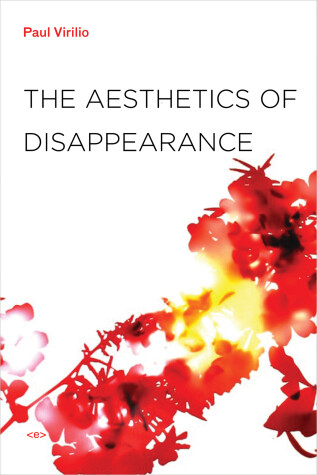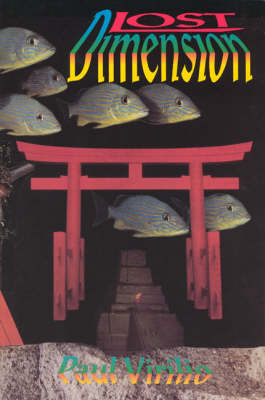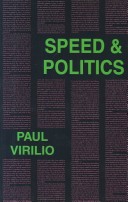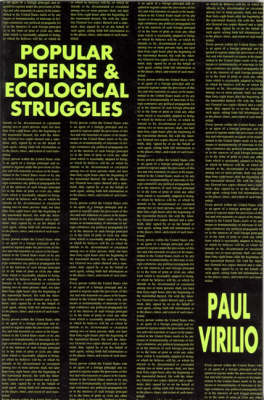Semiotext(e) / Foreign Agents
8 total works
Virilio and Lotringer revisit their prescient book on the invisible war waged by technology against humanity since World War II.
In June 2007, Paul Virilio and Sylvere Lotringer met in La Rochelle, France to reconsider the premises they developed twenty-five years before in their frighteningly prescient classic, Pure War. Pure War described the invisible war waged by technology against humanity, and the lack of any real distinction since World War II between war and peace. Speaking with Lotringer in 1982, Virilio noted the "accidents" that inevitably arise with every technological development: from car crashes to nuclear spillage, to the extermination of space and the derealization of time wrought by instant communication. In this new and updated edition, Virilio and Lotringer consider how the omnipresent threat of the "accident"-both military and economic-has escalated. With the fall of the Soviet bloc, the balance of power between East and West based on nuclear deterrence has given way to a more diffuse multi-polar nuclear threat. Moreover, as the speed of communication has increased exponentially, "local" accidents-like the collapse of the Asian markets in the late 1980s-escalate, with the speed of contagion, into global events instantaneously. "Globalization," Virilio argues, is the planet's ultimate accident.Paul Virilio was born in Paris in 1932 to an immigrant Italian family. Trained as an urban planner, he became the director of the Ecole Speciale d'Architecture in the wake of the 1968 rebellion. He has published twenty-five books, including Pure War (1988) (his first in English) and The Accident of Art (2005), both with Sylvere Lotringer and published by Semiotext(e). Sylvere Lotringer, general editor of Semiotext(e), lives in New York and Baja California. He is the author of Overexposed: Perverting Perversions (Semiotext(e), 2007) and other books.
Virilio introduces his understanding of "picnolepsy"-the epileptic state of consciousness produced by speed.
Virilio himself referred to his 1980 work The Aesthetics of Disappearance as a "juncture" in his thinking, one at which he brought his focus onto the logistics of perception-a logistics he would soon come to refer to as the "vision machine." If Speed and Politics established Virilio as the inaugural-and still consummate-theorist of "dromology" (the theory of speed and the society it defines), The Aesthetics of Disappearance introduced his understanding of "picnolepsy"-the epileptic state of consciousness produced by speed, or rather, the consciousness invented by the subject through its very absence: the gaps, glitches, and speed bumps lacing through and defining it. Speed and Politics defined the society of speed; The Aesthetics of Disappearance defines what it feels like to live in the society of speed. "I always write with images," Virilio has claimed, and this statement is nowhere better illustrated than with The Aesthetics of Disappearance. Moving from the movie theater to the freeway, and from Craig Breedlove's attainment of terrifying speed in a rocket-power car to the immobility of Howard Hughes in his dark room atop the Desert Inn, Virilio himself jump cuts from such disparate reference points as Fred Astaire, Franz Liszt, and Adolf Loos to Dostoyevsky, Paul Morand, and Aldous Huxley. In its extension of the "aesthetics of disappearance" to war, film, and politics, this book paved the way to Virilio's follow-up: the celebrated study, War and Cinema.This edition features a new introduction by Jonathan Crary, one of the leading theorists of modern visual culture. Foreign Agents seriesDistributed for Semiotext(e)
There is a catastrophe within contemporary art. What I call the "optically correct" is at stake. The vision machine and the motor have triggered it, but the visual arts haven't learned from it. Instead, they've masked this failure with commercial success. This "accident" is provoking a reversal of values. In my view, this is positive: the accident reveals something important we would not otherwise know how to perceive.-Paul Virilio, The Accident of Art
Urbanist and technological theorist Paul Virilio trained as a painter, studying under Henri Matisse, Georges Braque, Bazaine and de Stael. In The Accident of Art, his third extended conversation with Sylvere Lotringer, Virilio addresses the situation of art within technological society for the first time. This book completes a collaborative trilogy the two began in 1982 with Pure War and continued with Crepuscular Dawn, their 2002 work on architecture and biotechnology. In The Accident of Art, Virilio and Lotringer argue that a direct relation exists between war trauma and art. Why has art failed to reinvent itself in the face of technology, unlike performing art? Why has art simply retreated into painting, or surrendered to digital technology? Accidents, Virilio claims, can free us from speed's inertia. As technological catastrophes, accidents are inventions in their own right.
Do you ever get aroused by your patient's fantasies? Do you discover through them something about your own sexuality?
–About my sexuality?
You are exposed to a lot of fantasies.
–Oh yes. Quite frankly, I think it has a satiation effect on me. I've been a sex researcher for ten years, and sometimes I get fed up with it, you know. I talk to people about sex all day long, and it does get to be a drag.
–from Overexposed
The most perverse perversions are not always those one would expect. Originally conceived as an American update to Foucault's History of Sexuality, Overexposed is even more outrageous and thought-provoking today than it was twenty years ago when first published by a commercial publisher. By a strange reversal, rather than being punished, deviant desire now is administrated in specialized clinics under medical supervision. Sexual excess is being turned into a "boredom therapy" claiming to rid patients of their own desires by forcing them to indulge them past the point of satiety. But are perversions still perverse when they are vindicated unconditionally? At once clinical, bewildering, and deeply poignant, Overexposed shows how science can pervert itself by identifying too closely with its object. This insider's exposition of controversial cognitive behavioral methods (carried out with instruments straight out of A Clockwork Orange–penile transducer? pupillometer?) is a hallucinatory document on the manner in which our postmodern society exposes sexuality to the point of overexposure–in order to exterminate it.
Speed and Politics (first published in France in 1977) is the matrix of Virilio's entire work. Building on the works of Morand, Marinetti, and McLuhan, Virilio presents a vision more radically political than that of any of his French contemporaries: speed as the engine of destruction. Speed and Politics presents a topological account of the entire history of humanity, honing in on the technological advances made possible through the militarization of society. Paralleling Heidegger's account of technology, Virilio's vision sees speed—not class or wealth—as the primary force shaping civilization. In this "technical vitalism," multiple projectiles—inert fortresses and bunkers, the "metabolic bodies" of soldiers, transport vessels, and now information and computer technology—are launched in a permanent assault on the world and on human nature. Written at a lightning-fast pace, Virilio's landmark book is a split-second, overwhelming look at how humanity's motivity has shaped the way we function today, and what might come of it.
What is popular defense? From whom do we have to defend ourselves?
What is popular defense? From whom do we have to defend ourselves? Originally civilian populations were capable of defending themselves both in times of peace and war. A military racket was subsequently imposed upon them in the name of protection and popular defense lost its capacity to resist external attack. In case of total war, between the native populations which form the constitutional basis of all great modern states and the military now in charge of defending them there was no more "common culture." Industrial wars subsequently managed to replace the thousand-year-old pact of semi-colonization with total colonization. First experimented with in South America, this kind of "endo-colonization" (the military cracking down on its own population) was gradually extended to all the post-industrial countries through the exponential development of the techno-military complex.
Summarizes Virilio's speculations about the impact that accidents will have on the planet now that we operate on one-world time.
Based upon a 1996 conversation Paul Virilio had with French journalist Phillipe Petit, The Politics of the Very Worst summarizes Virilio's speculations about the impact that accidents will have on the planet now that we operate on one-world time. Virilio argues that accidents have now lost all particularity. Accidents and events can no longer be confined to markers in history like Auschwitz or Hiroshima. Trajectories once had three dimensions: past, present, and future. But now, the hyper-concentration of time into "real time" reduces all trajectories to nothing. Consequently, an accident of time is bound to affect our entire being as well as the entire planet. And this is the hidden face of technical and scientific progress that Virilio is attempting to reveal, shrugging off any illusion we may have left about its alleged benefits.Globalization doesn't make the planet bigger, it signals the beginning of "the great confinement." Speed pollutes the distances of the world. After the "green ecology" (the pollution of nature), we are now experiencing another, more invisible and mental, kind of pollution: the "gray ecology." Soon, Virilio suggests, we are going to experience the end of the world-not the apocalyptic end, but the world as finite. The communication revolution, the attainment of absolute speed, is the reduction of the world to a virtual city in which democracy is no longer possible. This extermination of world-space is a cataclysmic event. For the first time, history has hit a cosmological limit.







